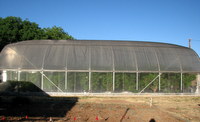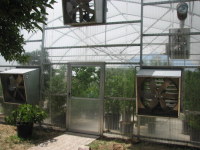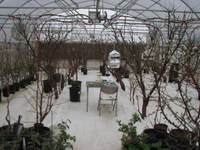We sell our products to retail nurseries, garden centers, container growers who sell to landscape contractors and retail nurseries, mail order nurseries, and anyone else who qualifies. We do not accept direct sales to consumers.
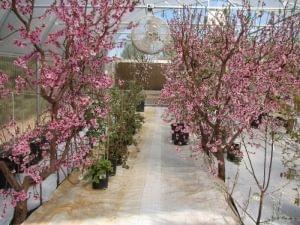 by Steven Winter
by Steven Winter
Professor, retired Texas A&M
A greenhouse, high tunnel, or other protective structure can greatly improve production and fruit quality in many climatic conditions. The ideal design of the structure is dependent on the crop, the objectives of the growing situation, and climate. With the proper structure, early blooming stone fruit and many other fruits could be grown in many parts of the USA where they are otherwise difficult to grow. A protective structure can increase yield and consistency of production, reduce diseases of tree and fruit, improve fruit appearance, and improve brix and sometimes flavor.
West Texas above 4,500 ft. elevation is ideally suited to greenhouse production of many fruits. Summers are cool and dry enough that greenhouse temperatures can be held in the ideal range. Winters are mild enough that heating costs are reasonable. A greenhouse of 1728 sq ft in Alpine, Texas costs about $50 per month for cooling and $300 per year for heating to 39F. Soil is a very well drained, deep, clay loam with moderate water holding capacity.
Winter chilling requires about 10-12 weeks with nights at 38-40F and days as cool as can be managed, about 55-60F. Winter chilling is aided by shade cloth and evaporative cooling. The crops requiring most chilling hours are sweet cherries and some apricots. The other fruits discussed need eight weeks of chilling or less. Summer cooling is achieved via wet wall and opposing 36 inch exhaust fans. The high temperatures in summer can be held below 95 F in a greenhouse in Alpine. Humidity is maintained as low as possible at all times.
All greenhouse fruit species listed have been grown both in-ground and in 5-15 gallon pots. Fruit quality can be superb from potted trees but it is more variable and the fruit is smaller. Brix levels listed are for in-ground trees mostly on Citation and Gisela 5 rootstocks spaced from 6ft by 8ft to 4ft by 3ft. Citation is precocious and increases fruit size but is very susceptible to crown gall. Grapes and figs are too vigorous planted in-ground in the greenhouse. Potting makes them much more manageable.
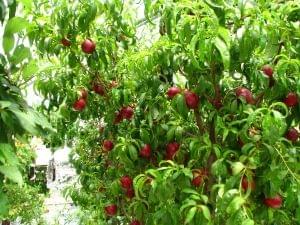 The key management issue for highest fruit eating quality is water. Limiting water lowers the water content of fruit and enhances both sweetness and flavor. Greenhouse average total water application is 28 inches per year. This equates to 1.0 inch every 10-21 days from May thru September (via drip) plus 7-8 inches by flooding in the dormant season, usually October or November, to leach salts and rewet the soil profile.
The key management issue for highest fruit eating quality is water. Limiting water lowers the water content of fruit and enhances both sweetness and flavor. Greenhouse average total water application is 28 inches per year. This equates to 1.0 inch every 10-21 days from May thru September (via drip) plus 7-8 inches by flooding in the dormant season, usually October or November, to leach salts and rewet the soil profile.
The watering regime could be described as deficit irrigation. The idea is to force the plant to adapt to a water deficit in spring by withholding irrigation until growth nearly ceases and then maintaining a water deficit all summer. The trees don't usually stop growing entirely in summer but growth is very limited. The water deficit has been taken too far if the trees begin to drop leaves or the fruit shrivels. This watering regime is most suitable and effective for the long season and late maturing grapes, pluot, and nectarine. Outdoors, it is suitable only for the very drought tolerant fruits: mainly grapes, jujube, and figs.
The floor of the greenhouse is covered with Extenday reflective fabric to increase light in the canopy, control weeds, and save water. This in part accounts for low greenhouse water needs. Light in the greenhouse is highly diffused by IRAC poly and ground fabric but is probably only 40 to 50% total PAR compared to outdoors.
Little or no fertilizer is applied to greenhouse fruits. It is generally not needed since the fruit trees are not competing with any ground cover vegetation.
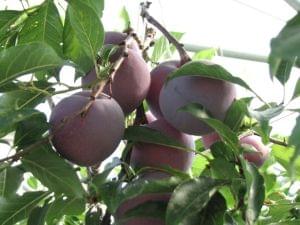 Average brix levels have been 18-25 for pluots and nectarines, 24-32 for sweet cherry, and 16-22 for apricots. Fruit size is generally good despite limiting water as much as possible. Flavor King Pluot®sometimes averages 200 grams and several nectarines 3-4 inches, ~300-450 grams. Fruit size is reduced at the greatest water deficits. For instance, nectarines running ~28 brix at higher water deficits are 50-70% the size of 18-22 brix fruit.
Average brix levels have been 18-25 for pluots and nectarines, 24-32 for sweet cherry, and 16-22 for apricots. Fruit size is generally good despite limiting water as much as possible. Flavor King Pluot®sometimes averages 200 grams and several nectarines 3-4 inches, ~300-450 grams. Fruit size is reduced at the greatest water deficits. For instance, nectarines running ~28 brix at higher water deficits are 50-70% the size of 18-22 brix fruit.
The key pest is spider mites, which build up in late May. There are many new miticides available for control.
The author’s single most favorite greenhouse grown fruit is Honey Royale nectarine for its sweet and incredibly rich flavor. Other favorites are the other Honey and Arctic series nectarines, Orangered and Robada apricot, Flavor Supreme and Flavor King Pluot® (pictured above), Strawberry Verte fig, Sweetcrisp blueberry, and Summer Royal grape. The greenhouse system produces very high quality fruit with limited production issues but cost of production is high.
| Table 1. Greenhouse Pluot® evaluation |
| Cultivar | Harvest | Brix | Flavor |
| Flavor Supreme | 6-1 | 24 | 9 |
| Geo Pride | 7-1 | 24 | 8 |
| Emerald Drop | 7-8 | 23 | 7 |
| Flavor Queen | 7-15 | 24 | 5 |
| Flavor King | 7-21 | 20 | 10 |
| Flavor Grenade | 7-21 | 24 | 7 |
| Crimson Royale | 8-1 | 24 | 8 |
| Honey Punch | 8-21 | 25 | 8 |
| Flavor Finale | 9-1 | 24 | 9 |
| Flavor Treat | 9-28 | 24 | 9 |
| Table 2. Greenhouse apricot/Aprium® evaluation |
| Cultivar | Harvest | Brix | Flavor |
| Tasty Rich Aprium® | 4-15 | 18 | 7 |
| Honey Rich Aprium® | 4-21 | 16 | 6 |
| Tomcot | 5-1 | 20 | 8 |
| Robada | 5-10 | 22 | 9 |
| Orangered | 5-21 | 21 | 10 |
| Golden Sweet | 5-28 | 22 | 7 |
| Table 3. Greenhouse nectarine evaluation |
| Cultivar | Harvest | Brix | Flavor |
| Honey May | 5-15 | 18 | 8 |
| Arctic Star | 6-1 | 24 | 9 |
| Arctic Sweet | 6-15 | 23 | 8 |
| Arctic Jay | 7-1 | 24 | 8 |
| Honey Fire | 7-1 | 24 | 8 |
| Honey Blaze | 7-1 | 25 | 9 |
| SpiceZee NectaPlum™ | 7-8 | 24 | 8 |
| Honey Royale | 7-15 | 23 | 10 |
| Honey Diva | 8-1 | 24 | 9 |
| Valley Sweet (peach) | 8-15 | 20 | 8 |
| Arctic Snow | 9-1 | 22 | 7 |
| Table 4. Greenhouse grape evaluation |
| Cultivar | Harvest | Brix | Flavor |
| Flame | 7-1 | 25 | 7 |
| Summer Muscat | 7-15 | 30 | 10 |
| Summer Royal | 7-21 | 26 | 8 |
| Princess | 8-1 | 24 | 7 |
| Autumn Royal | 9-1 | 24 | 6 |
| Crimson | 10-1 | 26 | 7 |
| Table 5. Greenhouse cherry evaluation |
| Cultivar | Brix | Flavor |
| Bing | 24 | 8 |
| Van | 30 | 10 |
| Lapins | 25 | 8 |
| Rainier | 28 | 7 |
| Sandra Rose | 32 | 9 |
| Selah | 32 | 8 |
| Royal Rainier | 30 | 8 |
| Skeena | 28 | 8 |
| Sonata | 28 | 8 |
| Regina | 26 | 5 |
| Craig's Crimson | 27 | 7 |
| Sweetheart | 26 | 7 |
| Chelan | 24 | 6 |
Dave Wilson Nursery comment
In the cultivar evaluations above, there is an assortment of home garden and commercial varieties; availability may be restricted. The flavor ratings are one person's opinions, albeit those of a dedicated fruit enthusiast and persistent experimenter. Also, such high-Brix fruit may be riper than some people prefer. In any case, the data is presented to further describe the possibilities for greenhouse fruit growing.
See also Brix: a measure of fruit sweetness
The author's (community-garden sized) greenhouse:

